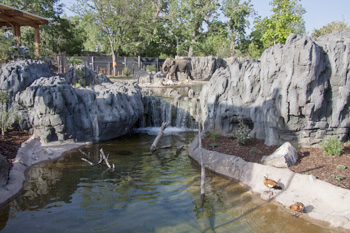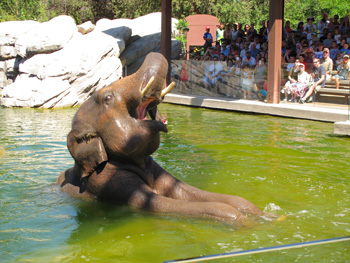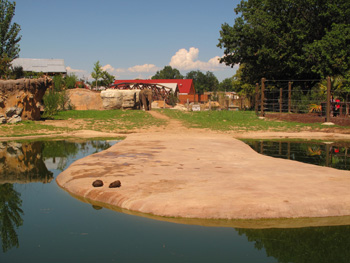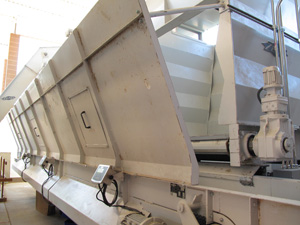New Exhibit at the Denver Zoo LEEDs Animals and Guests to a Unique Experience
 DENVER — The Denver Zoo’s new Toyota Elephant Passage welcomes visitors to a new kind of zoo experience, which provides sustainable, sophisticated and responsible measures for humans and animals alike.
DENVER — The Denver Zoo’s new Toyota Elephant Passage welcomes visitors to a new kind of zoo experience, which provides sustainable, sophisticated and responsible measures for humans and animals alike.
The Toyota Elephant Passage is the first large animal exhibit complex in the country to achieve LEED Platinum certification. The 10-acre exhibit is nothing short of remarkable. There are nearly 16 species housed at the new exhibit including Malayan tapirs; the greater one-horned rhino; the clouded leopard; as well as the main attraction: the Asian elephants (also known as bull elephants).
After a seven-year design process, the $50 million state-of-the-art facility started construction in 2009 and officially opened to the public this June. The exhibit was paid for with a bond issue as well as contributions from several donors, including a total donation of $5 million from Colorado neighborhood Toyota stores.
The thought, precision and execution of the design was made possible by the Denver Zoo sustainability “brain child,” George Pond. Pond is the vice president of design and campus management at the Denver Zoo and responsible for all the planning, design, new construction, capital projects, facility maintenance and sustainability efforts at the zoo. Pond wanted to translate the zoo’s passion for sustainability into the operations at the facility.
“It’s not enough for us to say we’re doing good work in eco-systems across the world for various species; we feel like we should demonstrate that in all of our operations, so we’ve been committed to that for several years,” said Pond.
The exhibit planners were somewhat hesitant in the initial design conception to go for LEED certification, as many members in the zoo industry would argue that LEED standards do not fit zoo exhibits and do not take into account the complexity of designing for animals and animal management, according to Pond.
 “In designing a zoo exhibit, your square footage and buildings are really committed to animals, not to human occupancy,” explained Pond.
“In designing a zoo exhibit, your square footage and buildings are really committed to animals, not to human occupancy,” explained Pond.
Pond explained that many participants at zoo conventions constantly talk about LEED certification and whether or not zoo exhibits should pursue certification. After careful consideration, Pond and his team decided not to judge the process without experiencing it first.
“We made a commitment in the beginning that we were going to follow LEED and go all the way with it, not necessarily focused on a level but focused on the process so we could go back and say, ‘look, this is what we learned.’”
The process of LEED certification can be a long and tedious process, and also costly. However, the Denver Zoo was committed to provide the latest sustainability practices to the new exhibit, and after experiencing the facility, it’s safe to say they delivered on their promises.
Designing for Animals
The project could not have been possible without the design execution of Philadelphia-based CLR Design, who has been nationally recognized for award-winning zoo designs, including other projects at the Denver Zoo, such as the primate exhibit, Predator Ridge, and the zoo’s front entry.
“We have a good relationship with them — they really understand us and how we work and think here. There’s really only a handful of qualified exhibit designers and they [CLR Design] really worked hard to see our vision come to life,” said Pond.
 Many local companies also contributed to the project including Englewood, Colo.-based general contractor Kiewit Building Group; Denver-based structural engineering firm Monroe & Newell Engineers, Inc.; mechanical, electrical and plumbing services from Lakewood, Colo.-based RMH Group Inc., and civil engineering services from Lakewood, Colo.-based SEH Inc.
Many local companies also contributed to the project including Englewood, Colo.-based general contractor Kiewit Building Group; Denver-based structural engineering firm Monroe & Newell Engineers, Inc.; mechanical, electrical and plumbing services from Lakewood, Colo.-based RMH Group Inc., and civil engineering services from Lakewood, Colo.-based SEH Inc.
Although the exhibit features several species, the main commitment since the beginning of the design process back in 2003, was to focus on the needs of the nearly extinct Asian elephants. The Denver Zoo offers something that doesn’t exist anywhere else in the world — the ability to effectively house bull elephants.
“We really committed to bull elephants and this exhibit isn’t replicated anywhere else in the world,” explained Pond. “It’s a commitment because Asian elephants are extremely endangered — in the wild and captivity there are only 35,000 total, versus nearly 600,000 African elephants — and part of the problem now is that people don’t have the space to hold bull elephants.”
Bull elephants are a lot larger and more destructive than African elephants, Pond explained. They are difficult to manage so building a structure specifically for their needs was something extremely important to Pond and the design team.
“People across the industry who have had success in breeding bull elephants have literally stopped breeding them in certain cases because if they have a baby they can’t handle — it’s not responsible and not something they can manage at another facility — we become the place that can handle that in North America and the entire world,” Pond said.
Prior to the new Toyota Elephant Passage, the Denver Zoo was unable to house any bull elephants in the park — now the new 10-acre exhibit can house up to eight bull elephants, according to Pond.
“Many zoos and other facilities are unable, or unwilling, to provide suitable housing for bull elephants, especially if the elephant is no longer able to breed,” according to a statement by Performing Animal Welfare Society (PAWS). “And very few are able to house more than one adult bull elephant.”
 By designing an exhibit that focuses on the needs and lifestyle of the animals, the Denver Zoo has become one of the go-to facilities when it comes to housing and breeding bull elephants.
By designing an exhibit that focuses on the needs and lifestyle of the animals, the Denver Zoo has become one of the go-to facilities when it comes to housing and breeding bull elephants.
The exhibit is also unique in the sense of its approach. The Toyota Elephant Passage uses a system called rotational exhibitry or flex-exhibitry, Pond explained.
“Toyota Elephant Passage has a rotational exhibit pattern that consists of two barns, one for elephants, one for rhinos and tapers, and six habitats that are all connected with redundant pathways in front of, behind, and through the exhibit, that essentially allows animals to be moving through the exhibit constantly, depending on what the keepers want to and need to do for those animals,” Pond said. “Once you walk into the exhibit as a guest you are completely surrounded by that.”
Water Conservation
Another component of the exhibit that stands out are the large pools for animals. Water conservation was a major factor in the zoo’s LEED Platinum certification.
“Water is really interesting in this exhibit. We have more than one million gallons of water in the exhibit, which is more than double the amount of water in the entire zoo,” Pond explained.
 Although the amount of water seems to conflict with sustainability efforts — the filtration system put in place at the zoo helps to recycle water within the new exhibit. The filtration system keeps nearly 850,000 gallons of the one million gallons circulated, according to Pond. The exhibit doesn’t have to dump and refill tanks constantly with the new system, which saves them money on their water bill as well as contributes to the zoo’s green efforts.
Although the amount of water seems to conflict with sustainability efforts — the filtration system put in place at the zoo helps to recycle water within the new exhibit. The filtration system keeps nearly 850,000 gallons of the one million gallons circulated, according to Pond. The exhibit doesn’t have to dump and refill tanks constantly with the new system, which saves them money on their water bill as well as contributes to the zoo’s green efforts.
The water in the pools comes from Denver Water, the city’s leading water utility company. Denver Water produces both potable water that consumers drink, but also produces recycled water, which is a product that comes from wastewater that’s treated to a very high level, but not considered potable for humans. The recycled water is used at the zoo for the new pools as well as irrigation throughout the park, according to Pond.
Turning Waste into Energy
The Denver Zoo is currently experimenting with a new, innovative waste-to-energy system that will convert 90 percent of the zoo’s total waste steam into clean energy. The system is estimated to reduce landfill contributions by 1.5 million pounds annually, while providing the power and heat needed to supply the new exhibit.
“For the first part of the process we needed to identify our waste stream. So I proposed an idea for our maintenance workers and said to them, ‘I want you to weigh every dumpster, everyday, forever, what do you think about that?’ I thought they would get up and walk out of the room, but because everyone here at the zoo is really focused on sustainability, they turned to me and said, ‘yes we’ll do it,’” Pond said.
The 162 green trashcans located throughout the zoo have a number that corresponds to a specific location within the zoo, so when the waste arrives at the weigh station, staff members know where the waste came from. The zoo has been enacting this policy for nearly four years, according to Pond.
“We know how much every container weights, what time it came in, where it came from, what the attendance was for that day, what the precipitation was, and from there we’ve created this very sophisticated data base. We’ve created a simulation model, which is one of our pieces of intellectual property that we’re patenting, to identify exactly how to calculate the flow of material and how we can work with that material — in 80 acres, 300 staff, 4,000 animals and 2 million visitors — and take that waste stream and start to blend it into a fuel source,” said Pond.
The process used at the zoo to convert waste to energy is known as gasification. Pond explained that the system wasn’t designed for him and his team without any understanding of what needed to be done, but instead they researched the process and were well versed in the mechanics behind the system.
 “A series of equipment starts to break the waste down into finer pieces to take the moisture content out,” Pond explained. “Gasification works best at 20 percent moisture content in a dense and consistent fuel, but we have nothing like that here. We have nothing close. We have a little bit of elephant poop over there, diapers over here and food waste everywhere else, so by using this system and breaking everything down we are able to convert the waste into the needed specifications for the gasification process.”
“A series of equipment starts to break the waste down into finer pieces to take the moisture content out,” Pond explained. “Gasification works best at 20 percent moisture content in a dense and consistent fuel, but we have nothing like that here. We have nothing close. We have a little bit of elephant poop over there, diapers over here and food waste everywhere else, so by using this system and breaking everything down we are able to convert the waste into the needed specifications for the gasification process.”
The system is very complex, but basically works like this: Once the waste is mixed and broken down into finer pieces it comes through a dryer where it continues to break down into smaller pieces and then is completely blended to contain about 25 to 30 percent moisture content. From there the waste is created into a fuel product that is dense and stable. It is then transported to the top of a gasifier that is located over an ash pit (the only physical byproduct). Next, the product turns into a synthetic gas, whose emissions are lessened as it is placed into an internal combustion engine, which is modified to work on that particular blend of gas. The engine provides electricity to support all of the systems motors, but also produce a surplus of net electricity that Pond and zoo staff members push out into the campus, with a tremendous amount of hot water. The hot water is stored in big tanks that run through a heat exchanger that supplies the central boiler building, which ultimately supplies hot water to all the buildings in the new exhibit including the rhino building, gibbon building, elephant building, leopard building and Village Hall, all of which are heated by support from this system.
“Depending on the needs for electricity and heat, we can many times satisfy 100 percent of the energy needs for this whole exhibit, and that’s where we get the metric that this system will offset 20 percent of the zoo’s electrical needs, because this exhibit represents 20 percent of our overall campus,” Pond said. “It won’t always be that way, we’ll get some really cold days where the boilers will have to bring the water a little bit more up to temperature or provide a little more energy, but there’s going to be plenty of days where we’re going to be running all of the heat just from this system.”
Pond explained that the new LEED Platinum exhibit is the greatest accomplishment of his career thus far, and the new standard for the Denver Zoo.
“We’re a leader in the world on sustainable zoo design and we’re proud to be a leader,” he said. “And once you start doing that it’s hard to go back, right?”
